We've been doing 3- to 5-week trips with our tandem for several years and hardly raised eyebrows on passersby. This trip has been different. We get asked at least every other day where we've biked from or where we're biking to, and when the questioner hears "Key West" or"Canada," the eyebrows raise indeed. We're not sure why it's different, but certainly have seen far fewer tandems in this corner of the country, and precious few long-distance bike tourers. Another more likely theory is that we are wearing red bike jerseys every day, riding our shiny-new red Rodriquez, and sporting those gorgeous bright red front and rear panniers that were Jeff's retirement gift from his office.
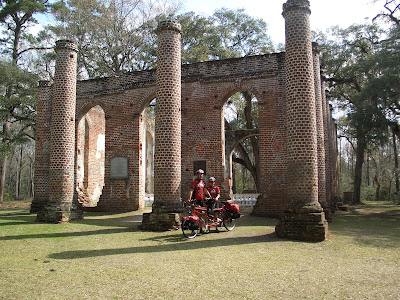
People just haven't seen even one person so "red" before, let alone a matched pair! BTW, we'll explain what we're in front of a few paragraphs down.
Two weeks ago Steve and Carol Huber had one of those conversations with us, and after a few minutes of more detailed questions about our trip asked if we planned to visit Hilton Head. "Yes, if we can find an affordable motel. Are there any?" Yes, they said, "But we have a better idea. Come stay with us." We gave them an ETA and continued on northward while they continued south by car on a short business trip.
We described last time how we island-hopped to Hilton Head (HH)via Daufuskie.
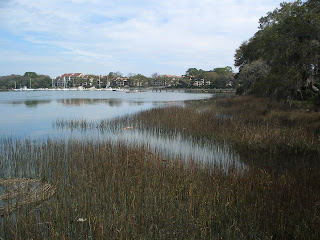
HH is a far larger island than Daufuskie, and connected to the mainland by a busy 4-lane road over a causeway and bridge. The west side is marshy with the Intracoastal running alongside, while the east side has miles of sandy beach on the Atlantic, hard enough for these cyclists to ride on but probably not for our
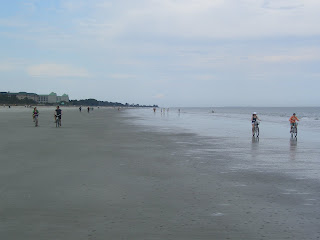
400 lbs. of bike, riders and luggage. In the middle of HH are houses, LOTS of them, and almost every one fairly new and attractive. What we discovered is that major portions of the island are gated off, some in small groups of houses but others in vast "plantations" containing thousands of homes and sometimes hotels.

Carol and Steve live in Hilton Head Plantation, and provided the gate with our names so we could enter and ride past a few golf courses and a few hundred houses to their gorgeous home overlooking the Atlantic. That's it from the beach, and the view from their guest bedroom at dawn the next morning!
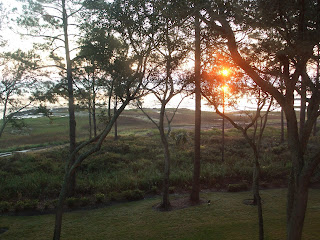
We had a terrific visit with them, which included a drive to the other end of HH for lunch on a deck overlooking a salt marsh, then a hike through a park we had been told by someone else to not miss, and which the Hubers had missed for the several years they have been coming to HH. We loved the walk on a boardwalk along what had once been a dike between two rice fields, when the park we were in was an antebellum rice plantation.
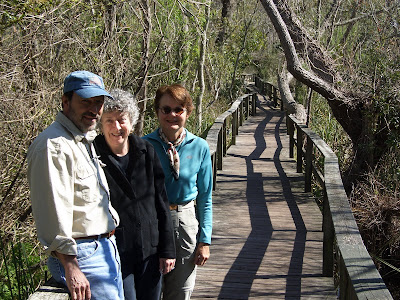
We finished up our second evening with them by showing them how to play our favorite card game, "Oh Hell," and by playing a fascinating board game of theirs, Blockus.
Between times we asked endless questions of each other about our respective life styles, like two teams of anthropologists comparing field notes from two very different cultural studies. Carol asked for and got a show and tell from Louise on how to pack a single pannier with every item of clothing you're going to use for a year, and Steve, with his technical background, got one on the mechanics of tandeming. In return we experienced their expertise in antique needlework. Their business website is http://www.antiquesamplers.com/, "America's Pre-eminent Source for Girlhood Embroideries." They gave us a private showing of two dozen samplers and other embroidered works, all 150 to 300 years old, that knocked our socks off.

We've put up one picture from their website as a sampler (sorry, that pun just called out to be used...), and suggest you visit their website to see many more beautiful works of needle art and to learn about this special form of Folk Art, for theirs is as informative a set of web pages as you're likely to see this year.
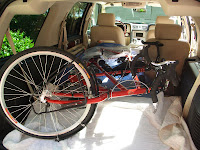
The Hubers then went
ueber the top on the second morning when they insisted on driving us out from HH. We tried to say no, but they finally convinced us that it was too dangerous to bike down Hwy 278. We found that we could get our tandem in their van without disassembly, and down 278 we drove and sure enough,it was a cyclist's nightmare, two and sometimes three lanes of heavy traffic in each direction, with no shoulders for significant parts of the way.

They let us off on Hwy 170, which was back to the 18" shoulder we've learned to live with in the Southeast, and gave parting hugs to close friends we scarcely knew two days earlier.
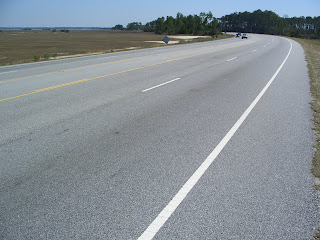
We did get one stretch of wide shoulder approaching Beaufort, but that was pretty much the only wide shoulder we've seen so far in 250 miles of biking in South Carolina.
SC and NC both have port cities named "Beaufort," but SC's is "byoo' fut" and NC's "bow' fut." Beaufort is the second-oldest city in SC, and very well preserved since the Union Navy seized it early in the Civil War (in what was the largest naval invasion by the US prior to Normandy!), and used it for military headquarters and hospital service throughout the war. We spent two nights in a B&B with a day and a half walking its historic streets. There were an amazing number of beautiful homes, but we'll focus on two.

The house with the red roof has been estimated to have been built anywhere from 1720 to 1780, depending on whose book you read. The porches look south, as do 98% of the porches in Beaufort no matter what side of a street the house sits on, since that captures the warmth of the winter sun and the cooling breezes of summer. The other side of this house overlooks a stunning marsh and river view to the north, and has an exceptionally large yard. It's now on the market and can be yours for $2.8 million.
The second house is the "Robert Smalls House." He was born a slave in a building behind the main house. As a teenager he was trained and hired out as a river pilot. After the fall of Ft. Sumter he was a pilot for the Confederate general responsible for the defense of Charleston. One night he and some black deck hands seized a Confederate boat loaded with supplies for their outlying forts and sailed out the harbor at 3 a.m., blowing the correct code on the boat whistle as he passed each fort, then raised a white flag as he approached the Yankee blockade fleet.
Back in Beaufort, the white planter class fled when the federals took over. The US government imposed a property tax, and when the planters failed to pay that tax, those gorgeous homes were sold at a tax sale.
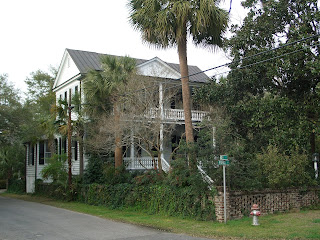
Robert Smalls showed up with his $1500 in reward money and bought the house where he had once been a slave. After the War the prior owner of the house, who had bought the house from Small's master and mistress before the War, sued to recover the house, and the case went all the way to the U.S. Supreme Court, which upheld Robert Smalls' purchase. After the War Smalls was himself elected five times to Congress, part of that small group of Black Congressment during Reconstruction.
One final story is worth telling about this house. One day Smalls' former mistress walked into the house, thinking in her senility that she was home again. Robert Smalls led her to her old room, made her comfortable, and housed her for her remaining days, even (or so the story goes) pretending to be her slave still. Hard to know how accurate the story is, but it certainly is compelling! Story or no, you can buy this little piece of American History as well. This one's a quite affordable $1.2 million, and comes with a plaque certifying that this is a National Landmark.
We left Beaufort on the bow wave of an approaching storm, and had a great tail wind north to Walterboro. A few days earlier we had decided to scratch Charleston from our itinerary due to concerns about the traffic and probable lack of shoulders on long stretches of road on that route. We have a paperback book with a bike route up the Atlantic Coast, and it recommended heading way inland and over mostly back roads, so off we went. It was a good choice, as they were mostly low-traffic, and they gave us a chance to see two things we otherwise would have missed.
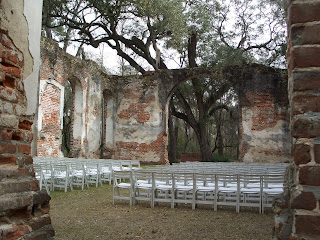
The first was the Sheldon Church Ruins, which we are standing in front of in the first picture of today's blog. The British burned the 1730 church in the Revolution, and about 50 years later the locals figured it was safe to rebuild it and did so. Then came the Civil War and General Sherman, and they have yet to get around to rebuilding it a second time.
Before we discuss Interesting Place No. 2, we do have more to say about that storm. It was supposed to hit in the evening, and it did, while we were in a restaurant next door to our Ramada Inn. There were TVs all over the dining room -- it was one of those kinds of places -- and one by one they all stopped showing basketball and sitcoms and turned to the weather radar. One tornado touched down in a storm cell running about 20 miles north of us, but the storm cell that had Walterboro in its crosshairs was said to "probably" not have one. We did make one mistake as the dark red center of this storm approached us on the tv screen. We were in a buffet restaurant and midway through our main course items, and we failed to get our soft-serve ice cream dessert. Sure enough, just when we were polishing off the main plate the glass windows chattered with hailstones bouncing off and, a minute later, the lights went out. There were two emergency lights so we were not in total darkness, and Louise had remembered our pocket flashlight, but we had to settle for chocolate pudding as the ice cream machine was done for the night. However the power came back at 11 pm, and all was fine the next day except for a new wind direction, more or less in our face for the next day.
Moncks Corner SC was special place number 2, and should be better known than it is,
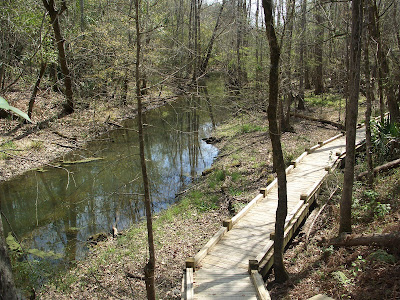
for the nation's first summit canal, one that goes up and down a rise, in this case up 35' in one direction and down 69' to sea level in the other. It was of course hand-dug, with slave labor, and opened in 1801. It brought cotton from the up country to Charleston and helped the upland planters and the Charleston merchants, but the investors largely saw their money sit earning little.

The south end of the canal is now a state park with four miles of trails, about a fourth of that boardwalk, and we walked every mile of it in awe and wonder. We saw about a hundred turtles but only one 'gator from the walk, then rented a canoe for an hour paddle and saw three more gators, one of whom slipped into the water toward us as we paddled by, which helped get our canoe speed up a bit, no matter what the experts say about whether gators think of us as food or not.

At the port city of Georgetown SC we returned to the coast, sort of. Georgetown is a bit inland of the ocean, as are all the other ports along the SC and NC coast, but it is a deepwater port with a large steel mill and paper mill at one end and a charming historic area at the other. While walking through the Rice Museum there we suddenly realized that we knew two people in another tour group walking by! It was Jim and Anita, the long-distance boaters we met on Daufuskie Island! Our hotel was less than a mile from their boat slip, so we walked over after checking into the hotel and had a glass of wine on their boat and dinner in a nearby restaurant. It was great to have more time to compare notes and get to know each other. Since they live in Port Townsend we agreed we will surely meet them again, although there is a fair chance it will happen again even sooner, as we are pursuing parallel paths north along the coast by bike and boat.
We'll end this long blog post with Brookgreen Gardens, an amazing place about 20 miles past Georgetown. Before the Civil War, a fourth of all the rice grown in the US was grown in the area around Georgetown, all on vast plantations worked by enormous numbers of slaves.
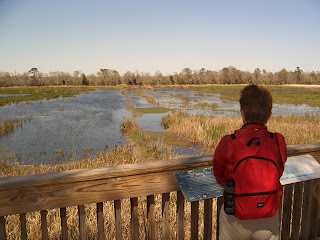
One of those planters, who owned Brookgreen Plantation and nine other plantations, was the only person in the 1850 census who owned more than 1000 slaves. Rice growing was only profitable when the planter could use slave labor, and there is probably a good dissertation in historical economics waiting to be written that analyzes from the rice plantation experience how much wealth was created by Black Americans but stolen from them by slavery.
In 1930 a wealthy couple came here from New York City seeking a better climate for the wife, who had TB. She was sculptor Anna Hyatt Huntington, he was Archer Huntington, Colis Huntington's sole heir. They purchased four plantations, 9000 acres, and began an outdoor sculpture garden for Anna's work and other sculpture that they collected.

It's now a collection of over 1000 sculptures, all figurative (not abstract),
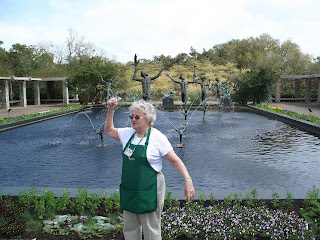
in a gorgeous setting in garden areas and sometimes overlooking the old rice fields that are reverting to marshland. In recent years they have begun focusing on the history of the plantations as well, and we took a tram to what was once the Ashley Oaks Plantation for a walk past the site of that plantation manor and some of the nearby buildings. This year they are extending that walk to where archaeologists have located the old slave quarters.
We're now on the Grand Strand, as the last 60 miles of the South Carolina coast surrounding Myrtle Beach now calls itself. Next blog will be from North Carolina.


